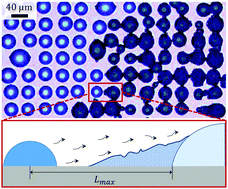How ice bridges the gap†
Abstract
When supercooled dew droplets form on a chilled surface, the subsequent freezing process is driven by a fascinating phenomenon of propagating inter-droplet ice bridges. Here, we explore the range of conditions under which an individual ice dendrite can successfully bridge the gap from a frozen droplet to its nearest liquid neighbor. Ranging the droplet sizes from 1 μm–10 mm, we find that the criterion for ice bridging is purely geometric and independent of temperature, ambient humidity, and surface wettability. We model the growth of individual ice bridges as well as the global speed of percolating fronts sweeping across large droplet populations. We also give a dynamical law for dry zone formation when ice fails to bridge the gap.



 Please wait while we load your content...
Please wait while we load your content...